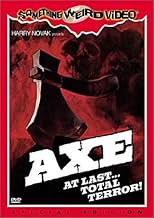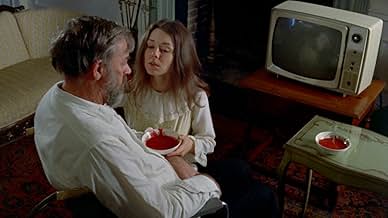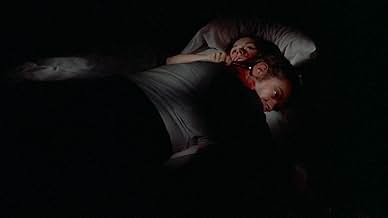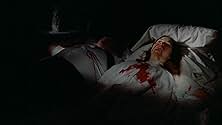PUNTUACIÓN EN IMDb
4,8/10
1,6 mil
TU PUNTUACIÓN
Añade un argumento en tu idiomaThree criminals on a murder spree arrives at a farmhouse, where a girl is living with her paralyzed grandfather.Three criminals on a murder spree arrives at a farmhouse, where a girl is living with her paralyzed grandfather.Three criminals on a murder spree arrives at a farmhouse, where a girl is living with her paralyzed grandfather.
Argumento
¿Sabías que...?
- CuriosidadesLeslie Lee had done some modeling prior to playing her sole lead role as Lisa. Lee declined an offer to be interviewed for the release of this movie by Severin Films in both the DVD and Blu-ray formats.
- PifiasWhen Lomax is making holes in clothes with his cigar, the amount of holes, his position and position of the clothes is not synchronized between shots.
- Versiones alternativasFor its original UK cinema release (as "California Axe Massacre") cuts were made to a razor slashing during a rape scene, the beating of Aubrey, and heavy edits to the infamous scene where the salesgirl is shot at and splashed with ketchup, and the film later found itself on the official DPP list of video nasties in the 80s. It was eventually issued on the Exploited video label, under its cinema title, in 1999 but received 19 secs of cuts to the previous razor slashing scene. The BBFC said they would have passed it uncut but previous illegal distribution of the uncut version led to a prosecution under the obscene publications act (the same reason Aquella casa al lado del cementerio (1981) and Blood Feast (1963) were slightly cut). The cuts were fully waived for the 2005 ILC release and the film reverted to its original title of "Axe".
- ConexionesEdited into Bloody Brothers (2007)
- Banda sonoraSmellin' Up The Kitchen
Written and Sung by George Newman Shaw and John Willhelm
Reseña destacada
As it happens, I was on the crew of LISA,LISA, which has been re-released as AXE (among other titles). I'm billed as Richard W. Helms. I did gaffing, focus pulling, and some sound, as well as some of the driving stunts (there weren't many, and most of them were not included in the finished film).
A lot of the reviewers have mentioned Frederick Friedel's choppy and cryptic direction of this film. Much of this may be due to the contributions by J.G 'Pat' Patterson who, with his wife Nita, performed most of the producing duties. Pat also did most of the cutting on the film - I recall visiting him in the editing bay at his Westinghouse Boulevard studios (actually just a warehouse) while he was piecing the film together. While my memory of events might be tainted after forty years, it does seem that there was a great deal of plot left on the cutting-room floor, because of time constraints placed on Patterson by his distributor. LISA,LISA was planned to play as part of a three-or-four film bill at local drive-ins, and the owners of those drive-ins didn't want people hanging in their cars TOO long without making a trip to the concession counter. It may be that the film's lack of characterization is attributable more to overenthusiastic editing than to inept directing or an incomplete screenplay.
To give you an idea just how low-budget this film was, all of the principle filming was completed in a little over a week and a half, at four locations - the soon-to-be torn down Hotel Charlotte in uptown Charlotte, NC; a convenience store in Charlotte; a lovely and very expensive Tudor home on Queens Road in Charlotte; and a vacated farmhouse near Waxhaw, south of Charlotte.
Most of the crew was paid a flat rate of $80-$100. That's not a per diem. It was $80 - $100 for the entire shooting schedule. This was late 1973, and a hundred bucks meant a lot more back then than it does now, but it was still chickenfeed. I have no idea what the actors were paid, but it wouldn't have been much more - certainly no more than a thousand for the principles and somewhat less for day players.
The film stock was rationed like water in a desert. Most of it was bought as left-over surplus stock from better-heeled production companies, and kept in a refrigerator in Pat Patterson's office. Retakes were discouraged.
The target audience, as has been noted several times by other reviewers, was the drive-in crowd who needed some background noise while they made out. For that reason, Patterson - through Rick Friedel - may have seen little need for such dramatic devices as back story and character development. In those days, people attending drive-in movies paid for darkness and privacy, not great cinema. Some have already alluded to Harry Novak's exploitation films, and he was involved with the distribution of this little gem.
One very important note is that the Director of Photography was Austin McKinney, who went on to work on a number of James Cameron films, including the Terminator series, and with John Carpenter in Escape From New York. Sadly, McKinney passed away late in 2013.
Some interesting notes - several people associated with this film died quite soon after it was completed, including Leslie Lee who played the main character, Lisa. She committed suicide sometime in the late 1970s.(NOTE!!!! Update 01/06/2013: I later discovered that this was not the case. This was the result of a conversation I had with another crew member in the 1980s, in which I was told that Leslie had killed herself. Leslie Lee, I am happy to say, is still alive and well, and lives alternately in Southern California and in Cabo San Lucas, Mexico). Two crew members, George Shaw and John Willhelm, died in a car crash on the way to Columbia, SC, in mid-1976. Pat Patterson died of cancer sometime in 1975, as memory serves. Rick Friedel, the titular director, was alive the last time I checked, but his career in feature films was pretty scant after the release of LISA, LISA / AXE.
LISA, LISA premiered at the Viking Twin Drive-In Theatre on Freedom Drive in Charlotte, NC, sometime in the fall of 1974. It played on a bill with a really silly movie called WHEN WOMEN HAD TAILS, or HOW WOMEN LOST THEIR TAILS - I can't recall the exact title - and a re-release of one of the PREACHERMAN films.
Despite the film's weaknesses - and there are many - I distinctly recall a strong sense among the crew at the time that we were doing something creative and interesting. Many crew members went on to work on other low-budget films, so we clearly didn't find this to be a negative experience.
For true fans of the bizarre drive-in exploitation films of the late 1960s and early 1970s, I'd suggest getting a copy of AXE. If nothing else, it shows that a bunch of college students can put together a movie that will last at least forty years.
A lot of the reviewers have mentioned Frederick Friedel's choppy and cryptic direction of this film. Much of this may be due to the contributions by J.G 'Pat' Patterson who, with his wife Nita, performed most of the producing duties. Pat also did most of the cutting on the film - I recall visiting him in the editing bay at his Westinghouse Boulevard studios (actually just a warehouse) while he was piecing the film together. While my memory of events might be tainted after forty years, it does seem that there was a great deal of plot left on the cutting-room floor, because of time constraints placed on Patterson by his distributor. LISA,LISA was planned to play as part of a three-or-four film bill at local drive-ins, and the owners of those drive-ins didn't want people hanging in their cars TOO long without making a trip to the concession counter. It may be that the film's lack of characterization is attributable more to overenthusiastic editing than to inept directing or an incomplete screenplay.
To give you an idea just how low-budget this film was, all of the principle filming was completed in a little over a week and a half, at four locations - the soon-to-be torn down Hotel Charlotte in uptown Charlotte, NC; a convenience store in Charlotte; a lovely and very expensive Tudor home on Queens Road in Charlotte; and a vacated farmhouse near Waxhaw, south of Charlotte.
Most of the crew was paid a flat rate of $80-$100. That's not a per diem. It was $80 - $100 for the entire shooting schedule. This was late 1973, and a hundred bucks meant a lot more back then than it does now, but it was still chickenfeed. I have no idea what the actors were paid, but it wouldn't have been much more - certainly no more than a thousand for the principles and somewhat less for day players.
The film stock was rationed like water in a desert. Most of it was bought as left-over surplus stock from better-heeled production companies, and kept in a refrigerator in Pat Patterson's office. Retakes were discouraged.
The target audience, as has been noted several times by other reviewers, was the drive-in crowd who needed some background noise while they made out. For that reason, Patterson - through Rick Friedel - may have seen little need for such dramatic devices as back story and character development. In those days, people attending drive-in movies paid for darkness and privacy, not great cinema. Some have already alluded to Harry Novak's exploitation films, and he was involved with the distribution of this little gem.
One very important note is that the Director of Photography was Austin McKinney, who went on to work on a number of James Cameron films, including the Terminator series, and with John Carpenter in Escape From New York. Sadly, McKinney passed away late in 2013.
Some interesting notes - several people associated with this film died quite soon after it was completed, including Leslie Lee who played the main character, Lisa. She committed suicide sometime in the late 1970s.(NOTE!!!! Update 01/06/2013: I later discovered that this was not the case. This was the result of a conversation I had with another crew member in the 1980s, in which I was told that Leslie had killed herself. Leslie Lee, I am happy to say, is still alive and well, and lives alternately in Southern California and in Cabo San Lucas, Mexico). Two crew members, George Shaw and John Willhelm, died in a car crash on the way to Columbia, SC, in mid-1976. Pat Patterson died of cancer sometime in 1975, as memory serves. Rick Friedel, the titular director, was alive the last time I checked, but his career in feature films was pretty scant after the release of LISA, LISA / AXE.
LISA, LISA premiered at the Viking Twin Drive-In Theatre on Freedom Drive in Charlotte, NC, sometime in the fall of 1974. It played on a bill with a really silly movie called WHEN WOMEN HAD TAILS, or HOW WOMEN LOST THEIR TAILS - I can't recall the exact title - and a re-release of one of the PREACHERMAN films.
Despite the film's weaknesses - and there are many - I distinctly recall a strong sense among the crew at the time that we were doing something creative and interesting. Many crew members went on to work on other low-budget films, so we clearly didn't find this to be a negative experience.
For true fans of the bizarre drive-in exploitation films of the late 1960s and early 1970s, I'd suggest getting a copy of AXE. If nothing else, it shows that a bunch of college students can put together a movie that will last at least forty years.
- PatGallegher
- 22 dic 2007
- Enlace permanente
Selecciones populares
Inicia sesión para calificar y añadir a tu lista para recibir recomendaciones personalizadas
- How long is Axe?Con tecnología de Alexa
Detalles
Taquilla
- Presupuesto
- 25.000 US$ (estimación)
Contribuir a esta página
Sugerir un cambio o añadir el contenido que falta

Principal laguna de datos
By what name was Lisa, Lisa (1977) officially released in India in English?
Responde

























